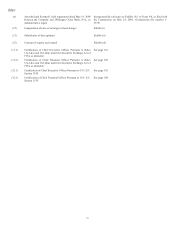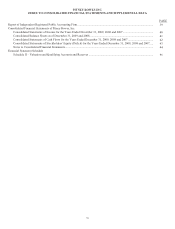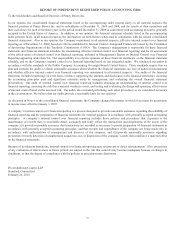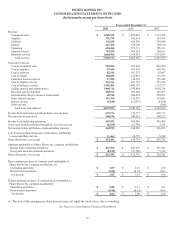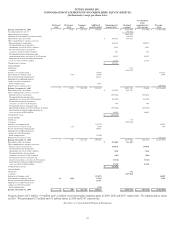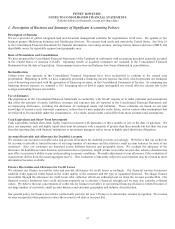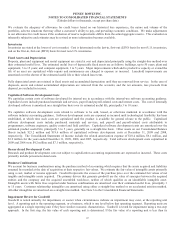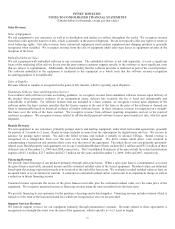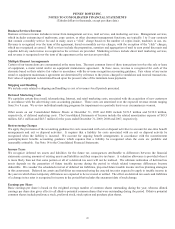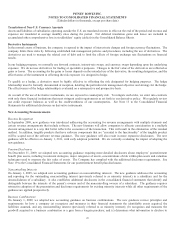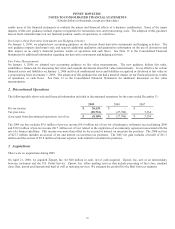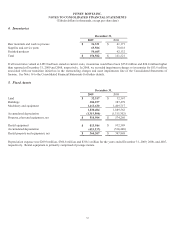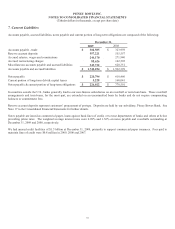Pitney Bowes 2009 Annual Report Download - page 63
Download and view the complete annual report
Please find page 63 of the 2009 Pitney Bowes annual report below. You can navigate through the pages in the report by either clicking on the pages listed below, or by using the keyword search tool below to find specific information within the annual report.PITNEY BOWES INC.
NOTES TO CONSOLIDATED FINANCIAL STATEMENTS
(Tabular dollars in thousands, except per share data)
45
We evaluate the adequacy of allowance for credit losses based on our historical loss experience, the nature and volume of the
portfolios, adverse situations that may affect a customer’s ability to pay, and prevailing economic conditions. We make adjustments
to our allowance for credit losses if the evaluation of reserve requirements differs from the actual aggregate reserve. This evaluation is
inherently subjective and estimates may be revised as more information becomes available.
Inventories
Inventories are stated at the lower of cost or market. Cost is determined on the last-in, first-out (LIFO) basis for most U.S. inventories,
and on the first-in, first-out (FIFO) basis for most non-U.S. inventories.
Fixed Assets and Depreciation
Property, plant and equipment and rental equipment are stated at cost and depreciated principally using the straight-line method over
their estimated useful lives. The estimated useful lives of depreciable fixed assets are as follows: buildings, up to 50 years; plant and
equipment, 3 to 15 years; and computer equipment, 3 to 5 years. Major improvements which add to productive capacity or extend the
life of an asset are capitalized while repairs and maintenance are charged to expense as incurred. Leasehold improvements are
amortized over the shorter of the estimated useful life or their related lease term.
Fully depreciated assets are retained in fixed assets and accumulated depreciation until they are removed from service. In the case of
disposals, assets and related accumulated depreciation are removed from the accounts, and the net amounts, less proceeds from
disposal, are included in income.
Capitalized Software Development Costs
We capitalize certain costs of software developed for internal use in accordance with the internal-use software accounting guidance.
Capitalized costs include purchased materials and services, payroll and payroll-related costs and interest costs. The cost of internally
developed software is amortized on a straight-line basis over its estimated useful life, principally 3 to 10 years.
We capitalize software development costs related to software to be sold, leased, or otherwise marketed in accordance with the
software industry accounting guidance. Software development costs are expensed as incurred until technological feasibility has been
established, at which time such costs are capitalized until the product is available for general release to the public. Capitalized
software development costs include purchased materials and services, and payroll and payroll-related costs attributable to
programmers, software engineers, quality control and field certifiers. Capitalized software development costs are amortized over the
estimated product useful life, principally 3 to 5 years, generally on a straight-line basis. Other assets on our Consolidated Balance
Sheets include $23.2 million and $19.6 million of capitalized software development costs at December 31, 2009 and 2008,
respectively. The Consolidated Statements of Income include the related amortization expense of $10.4 million, $6.1 million, and
$3.9 million for the years ended December 31, 2009, 2008, and 2007, respectively. Total software development costs capitalized in
2009 and 2008 were $9.2 million and $7.1 million, respectively.
Research and Development Costs
Research and product development costs not subject to capitalization accounting requirements are expensed as incurred. These costs
primarily include personnel-related costs.
Business Combinations
We account for business combinations using the purchase method of accounting which requires that the assets acquired and liabilities
assumed be recorded at the date of acquisition at their respective fair values. We estimate the fair value of intangible assets primarily
using a cost, market or income approach. Goodwill represents the excess of the purchase price over the estimated fair values of net
tangible and intangible assets acquired. The primary drivers that generate goodwill are the value of synergies between the acquired
entities and the company and the acquired assembled workforce, neither of which qualifies as an identifiable intangible asset.
Intangible assets with finite lives acquired under business combinations are amortized over their estimated useful lives, principally 3
to 15 years. Customer relationship intangibles are amortized using either a straight-line method or an accelerated attrition method.
All other intangibles are amortized on a straight-line method. See Note 6 to the Consolidated Financial Statements.
Impairment Review for Goodwill
Goodwill is tested annually for impairment, or sooner when circumstances indicate an impairment may exist, at the reporting unit
level. A reporting unit is the operating segment, or a business, which is one level below that operating segment. Reporting units are
aggregated as a single reporting unit if they have similar economic characteristics. Goodwill is tested for impairment using a two-step
approach. In the first step, the fair value of each reporting unit is determined. If the fair value of a reporting unit is less than its



